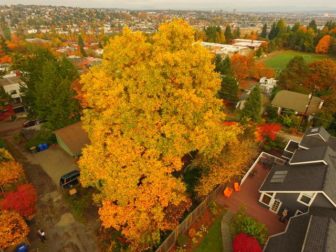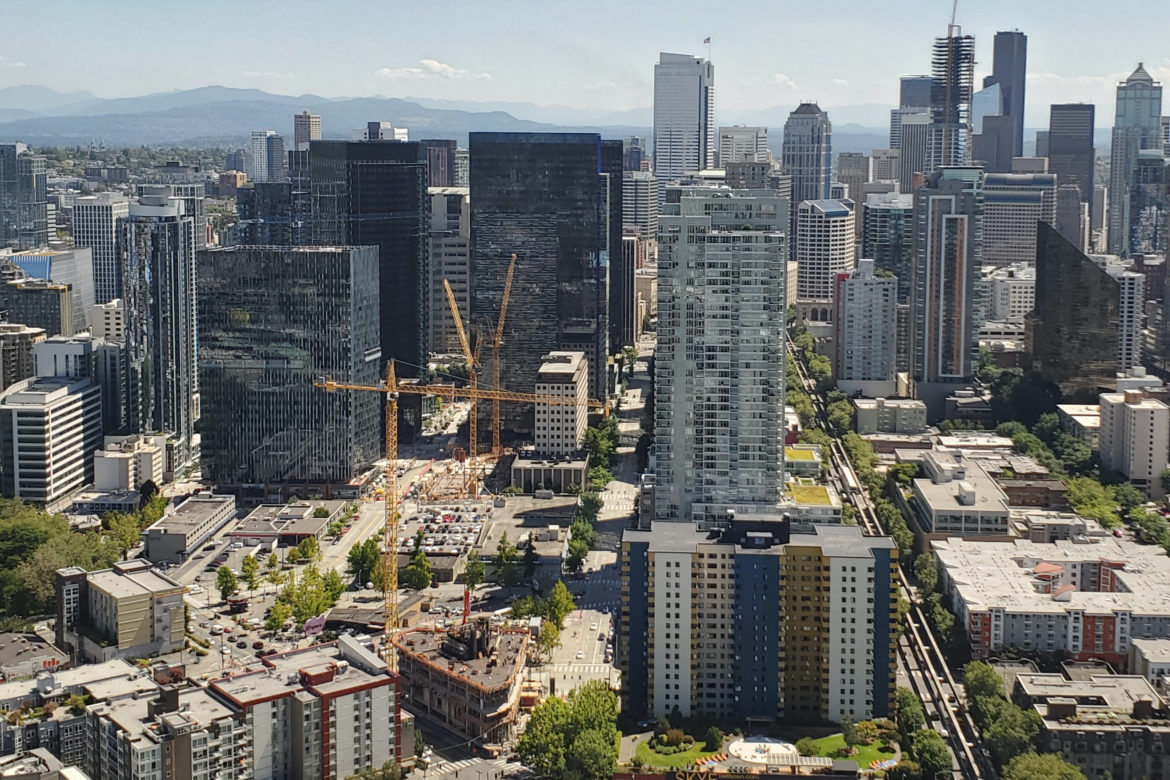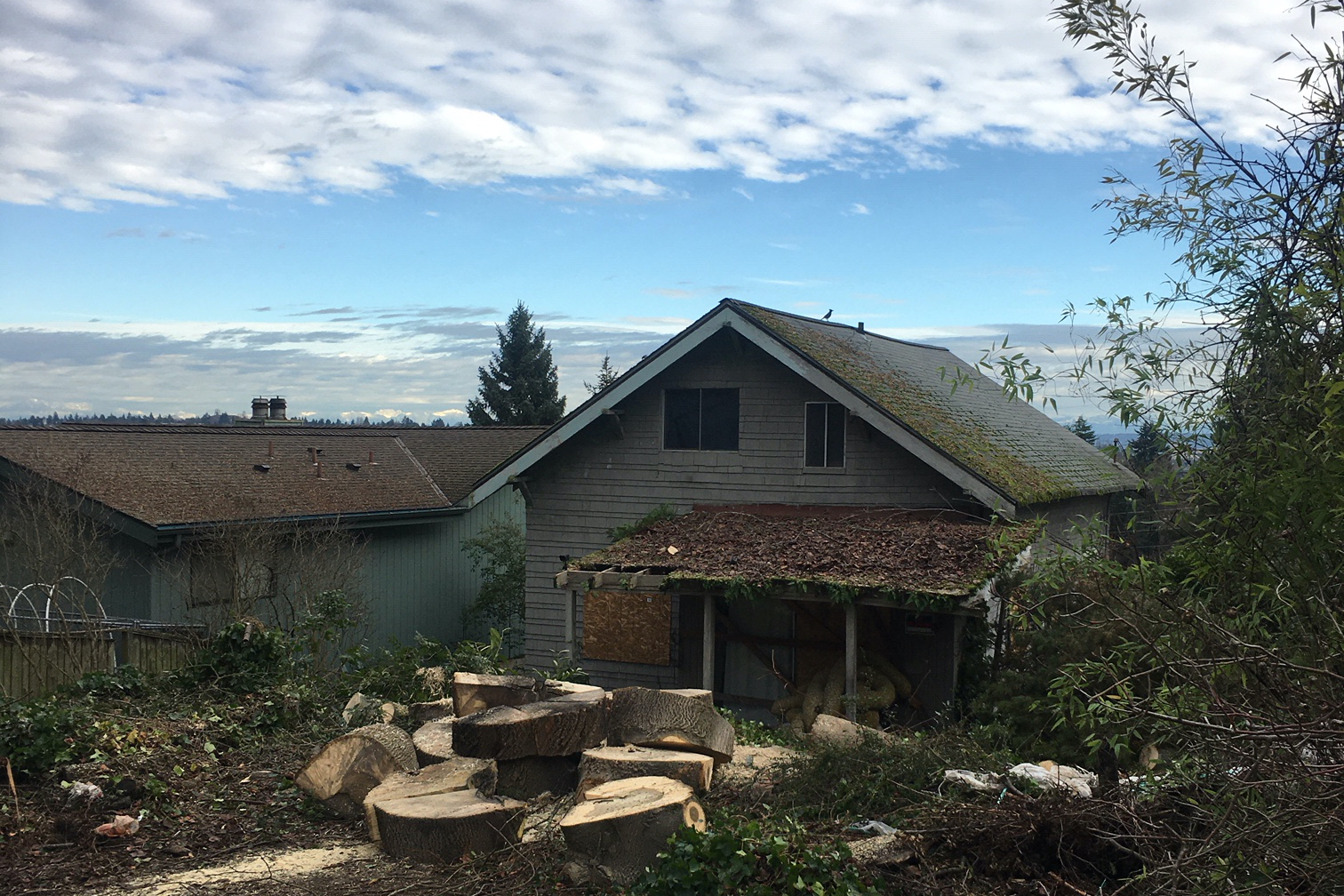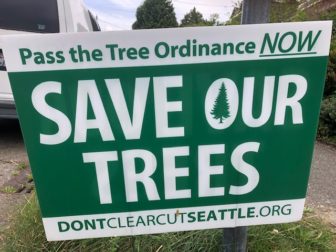It wasn’t your typical drowsy mid-morning Seattle City Council committee meeting. Suzanne Grant saw to that. Earlier this year, before the coronavirus ground much of Seattle civic life to a halt, the Queen Anne resident signed up solo to address members of the City Council’s Land Use & Neighborhoods Committee about updating Seattle’s tree-protection ordinance. But when Grant approached the microphone, she wasn’t alone. And she didn’t talk.
She sang.
“There’s a hole in the sky where the tree once was. Somebody’s making money,” Grant belted out, backed by a chorus of four other activists, one dressed in a homemade tree costume. “… A magnificent tree was murdered. The mighty dollar cut it down.”
As the song ended and her backup singers took their seats, the song left Grant’s voice.
She looked deadpan at the committee. “Pass the tree ordinance now,” she said.
Video of Grant’s passionate performance was tweeted by a reporter for The Stranger, and so far the “Tree Murder Song” has been viewed more than 800,000 times.
A hole in the neighborhood

This drone image captures the iconic tulip tree that inspired Suzanne Grant’s “Tree Murder Song.” The tree was cut down by developer Filthy LLC, which purchased the property from MGT Builders after MGT received a permit to cut down the tree.
While the pageantry of an arboreal-themed Broadway-style performance garnered smiles — and a gentle warning from the committee chair for the breach in protocol — Grant is serious about letting the city know there is literally a hole in her Queen Anne neighborhood where there was a nearly 90-foot-tall tulip tree with a trunk diameter of 44 inches. Grant believes the tree could have been saved if Seattle had a stronger tree ordinance.
Neighbors near Rodgers Park say they spent thousands of dollars to try to force the developer to preserve the tree towering behind the 1912 single-family home. They even hired an architect to draw up alternative plans to build the townhouse development around it but a city hearing examiner said it was too late in the process to make that part of the neighbors’ appeal.
The developer, Alex Mason of MGT Builders, acknowledged the tree was “exceptional” by the city’s rules, meaning it’s big enough, old enough and rare enough to be preserved. But Mason argued in a so-called “Streamlined Design Review” before the Seattle Department of Construction and Inspections that with the tree in the way, the development potential of this multifamily-zoned lot would be reduced from 3,048 square feet to 1,297 square feet. And that’s all developers have to do to get permission to cut down an exceptional tree. “If you are developing your property,” the SDCI website says, “you may remove trees if retaining them prevents you from achieving the allowed lot coverage or floor area of the site’s land use zone.”
Last summer, a city hearing examiner ruled in favor of MGT Builders by granting a master use permit for the project, which included permission to cut down the exceptional tulip tree. MGT Builders quickly sold the property to another developer, Filthy LLC. Records show Filthy LLC paid $1,650,000 for the property — $530,000 more than MGT Builders paid even though nothing new had been built yet. But MGT had gotten permission to cut down the tree.
The permission was granted by the city hearing examiner because the developer promised to plant trees that would eventually grow large enough to replace the canopy provided by the tulip tree.
Filthy LLC’s principal, Christopher Tui Masaniai, says he doesn’t like cutting trees down and in some of his other developments has gone the extra mile in the permitting process to save trees. “But in this case the tree was already permitted to be cut down,” he said. He did just that the day after Christmas. He says the neighbors are still furious with him.
“I have been hated since the day I bought the property. It’s not been a good experience,” he said.
Dramas like these are playing out from Northgate to Georgetown, Ballard to Sandpoint. Neighbors mourn as trees fall to make room for another block of apartments and row houses to shelter newcomers in Seattle, which was the fastest-growing big city in America over the last decade. The population has seen an influx of some 171,000 new residents, ballooning from 608,000 in 2010 to a projected 779,000 by the middle of this year.
In 1970, 40% of Seattle was shaded by trees, according to American Forests, a national tree-conservation group. In 2016, laser technology measured tree canopy in Seattle at 28%. Not even the city knows how many trees have been lost in this most recent building boom because, unlike cities including Portland, Chicago, Atlanta and Vancouver, B.C., permits are not required to remove trees on private property in Seattle. That’s one of the features tree-loving Seattleites are pushing for in a new ordinance.
“The city doesn’t know a tree is coming down unless a neighbor complains,” says Steve Zemke, a member of the city’s volunteer Urban Forestry Commission, which advises the City Council and mayor. “Neighbors don’t know a tree is being cut down until they hear the chain saw.” The Forestry Commission wants city permits to remove trees to come with a requirement that nearby residents be notified ahead of time and given a chance to challenge tree removals.
“Temporary” ordinance: 12 years and counting
In case you missed it, the big news here is that the Seattle City Council is at the beginning stage of possibly creating a new tree ordinance. Those words don’t sound like barn burners to most of us. But it’s a big deal to activists like Zemke who hope the new ordinance will protect trees in ways the old one doesn’t: requiring permits to cut down trees, creating a definition that would grant more trees “exceptional” status, and having arborists verify that “hazard” trees really are unsafe and need to be cut down. Advocates want the ordinance to create an entity in charge of protecting trees — a task that’s currently split among nine city departments.
The movement to protect more trees appears to be gaining momentum, with those green “Save Our Trees/Pass the Tree Ordinance Now” signs popping up in yards and along roadways all over town – including a few just down the street from the Filthy LLC house.

Under the current tree ordinance, private homes like this one in Seattle’s Fremont neighborhood aren’t required to get permits to remove trees, so there’s no way to track how many the city has lost.
During the economic boom times that followed the Great Recession, many cities updated their codes to give trees a fighting chance against development. In 2017, Mercer Island shrank the percentage of a residential lot that can be built on and made it nearly impossible to cut down big trees.
Portland’s 2015 tree law requires that developers leave one-third of healthy trees on private lots and Portland is considering an amendment that would extend tree protection to commercial and industrial land.
Seattle hasn’t updated its ordinance since 2008. That legislation was supposed to be temporary until a stronger measure could be passed in the next year or so.
In the intervening 12 years, there have been other efforts to create a new tree ordinance, but they all died on the vine. Ironically, it was the pro-density Mandatory Housing Affordability (MHA) plan that reinvigorated the current push for tree protections. During wrangling over MHA, the city said publicly that the current tree ordinance was working. Behind the scenes, Director of the Seattle Department of Construction and Inspections (SDCI) Nathan Torgelson asked for an internal study, which came to a different conclusion.
“The research revealed that current regulations and enforcement practices were not supporting tree protection,” a city memo said. “Exceptional trees and groves have been removed, with most removals occurring in Environmentally Critical Areas, particularly landslide-prone areas. New development has contributed to the loss of trees.”
The research was not publicly released when it was completed in March 2017. But Zemke in June 2017 noticed a footnote in a city document on the Mandatory Housing Affordability ordinance that mentioned it. “When I started inquiring as to where I could find a copy of the report, what I was told by a city staffer was that someone made a mistake — that it wasn’t meant to be made public ,” Zemke says.
He filed a public records request in September and got the report in October. Consider that it took a request under the Washington Public Records Act for this member of the city’s advisory Urban Forestry Commission to see the city’s work, even though the city staffer assigned to help the commission, Sandra Pinto del Bader, was one of the authors of the report.
Since Zemke shared the results with the city’s Urban Forestry Commission, which advises the City Council about preserving the urban tree canopy, the city Construction and Inspections Department has posted the research on its website and activists have been pointing to what they call the “smoking gun” of that report to get the City Council back on the tree protection beat. And that’s where things stood when the coronavirus lockdowns started: another stab at improved tree protection in 2020. But this time, tree advocates said, the result could be different because there are some fresh faces on the council who gave the impression of being pro-tree during their campaigns.
Alex Pedersen may prove to be the most tree-centric person on the council. His campaign platform called for “preventing the removal of most trees prior to and during construction projects” on the grounds that “existing large trees have the most positive impact in absorbing harmful carbon emissions.”
Pedersen and fellow new City Councilmember Dan Strauss have stated they’re committed to creating stronger tree protection legislation in 2020. They are both on the Land Use & Neighborhoods Committee that the ordinance needs to clear in order to move on to the full council. Strauss is committee chairman — the one who gently remonstrated Suzanne Grant for her council-meeting crooning. (Force of habit: She was a member of the pioneering Seattle punk band The Enemy four decades ago.)
What might the revamped ordinance look like? Rules the council and the lead city department, SDCI, will be considering include requiring a permit to remove trees 6 inches in diameter or larger and requiring that trees that are cut down are replaced. If the tree can’t be replaced on site, the homeowner or developer could pay a “fee in lieu” that the city would use to plant trees elsewhere. This is controversial. Portland made that part of its ordinance. But in a briefing to Seattle council members, Portland’s urban forestry manager, Casey Jogerst, warned against the fee because it gives developers a way to “buy our way out” when they scrape a site clean of trees.
Zemke favors the fee because the city will get something for lost trees and the money could be used to plant more trees in places that need them, like South Seattle. According to the city, neighborhoods with the most residents of color and the lowest incomes have the least amount of tree cover.
That’s the social justice piece that could give tree protection more diverse support in 2020. This summer South Seattle will be baking in stark sunlight with only about 11% tree canopy in neighborhoods like South Park. With roughly 35% canopy cover, leafy north-end neighborhoods will have it made in the shade. And we aren’t just talking about heat, but also health. Asthma in the Duwamish Valley, including childhood asthma, is much worse than the city’s overall asthma rate in part because residents in South Seattle, many of them poor, are exposed to diesel fuel pollution and there aren’t many trees to intercept that soot, suck up carbon dioxide and push out oxygen.
Size matters
Which leads us to the other driver that could lead to stronger tree protections: the growing body of evidence that trees are ground soldiers in the battle against climate change. University of Washington social scientist Kathleen Wolf focuses her research on how nature in cities improves human health. She believes Seattle’s mature trees are irreplaceable. “The takeaway is that big trees provide exponentially more benefit than tiny trees,” Wolf says. “People are planting species that are frilly, fussy trees that will never provide the level of environmental service of the big trees.”
That environmental service is quantifiable. Let’s circle back to the doomed tulip tree that inspired the “Tree Murder Song.” Plugging info on the 44-inch-diameter tulip tree into the National Tree Benefit Calculator, which uses data from the U.S. Forest Service, we find that single large tulip tree provided $143 a year in benefits including intercepting rain that would otherwise become polluted stormwater runoff, improving air quality and cooling air temperatures.
Seattle already has protections for so-called “exceptional” trees. In the past, that has been defined as trees with a diameter at breast height of 30 inches. A change under consideration would protect more of Seattle’s senior trees by shrinking the definition of exceptional to 24 inches. But advocates say that won’t make a difference until the “hazard tree” loophole is addressed.
According to the city memo, property owners “appeared to be using the broad definition of hazard trees to circumvent regulations, allowing them to remove trees and avoid replacement requirements.”
The City Council will be looking into ways to plug that loophole including bigger fines, better enforcement and licensing private arborists who will uphold Seattle’s tree regulations.
No clear-cut compromise
But here’s the rub. When all of these measures are considered by the City Council and weighed against Seattle’s rocketing growth — the need for housing, the desire of developers to capture a piece of that pie, and the aspiration of city leaders to transform the Emerald City into less of a leafy backwater and more of a world-class urban player — trees can look like a luxury. Or even a chess piece that can be used by NIMBYs. If tree regulations are strengthened, could residents use trees to defeat an apodment building they just don’t want in their backyard?

Construction projects are scattered throughout Seattles’s neighborhoods as the city’s population is set to balloon to a projected 779,000 people by the middle of this year, leaving the City Council to weigh the need for housing against the preservation of the tree canopy.
In the committee meeting in February, City Councilmember Andrew Lewis put it this way: “I want to make sure we are designing an ordinance around protecting essential trees rather than simply preventing unwanted development.”
In the tree advocate camp, there’s concern that real protection won’t happen as long as the Seattle Department of Construction and Inspections is the lead department for the ordinance. “DCI has an inherent conflict of interest,” says Zemke. “Their main job is to help builders build. Trees need their own advocate.”
Bryan Stevens with SDCI responds: “We don’t see this as a conflict of interest. SDCI’s mission is to manage growth and promote a safe and livable Seattle through compliance with development regulations and design guidelines.”
As chairman of the Land Use & Neighborhoods Committee, Dan Strauss hopes to broker some kind of peace that will allow the council to push a new tree ordinance across the finish line.
“I’ve noticed there is tension between activists and departments,” Strauss says. “Having an adversarial relationship does not help with this.” What would help, Strauss says, is for everyone to approach tree protection in a spirit of partnership and with cooler heads.
Looking at the lot where the tulip tree was, now covered in concrete townhouse foundations from street to alley, songstress Grant has no intention of dialing it down.
“When I knew we had lost the fight to save this one exceptional tree, it made me more determined,” she says. “Trees are the answer!”
Sounds like there might be the seed of a new song in there somewhere, taking root.




